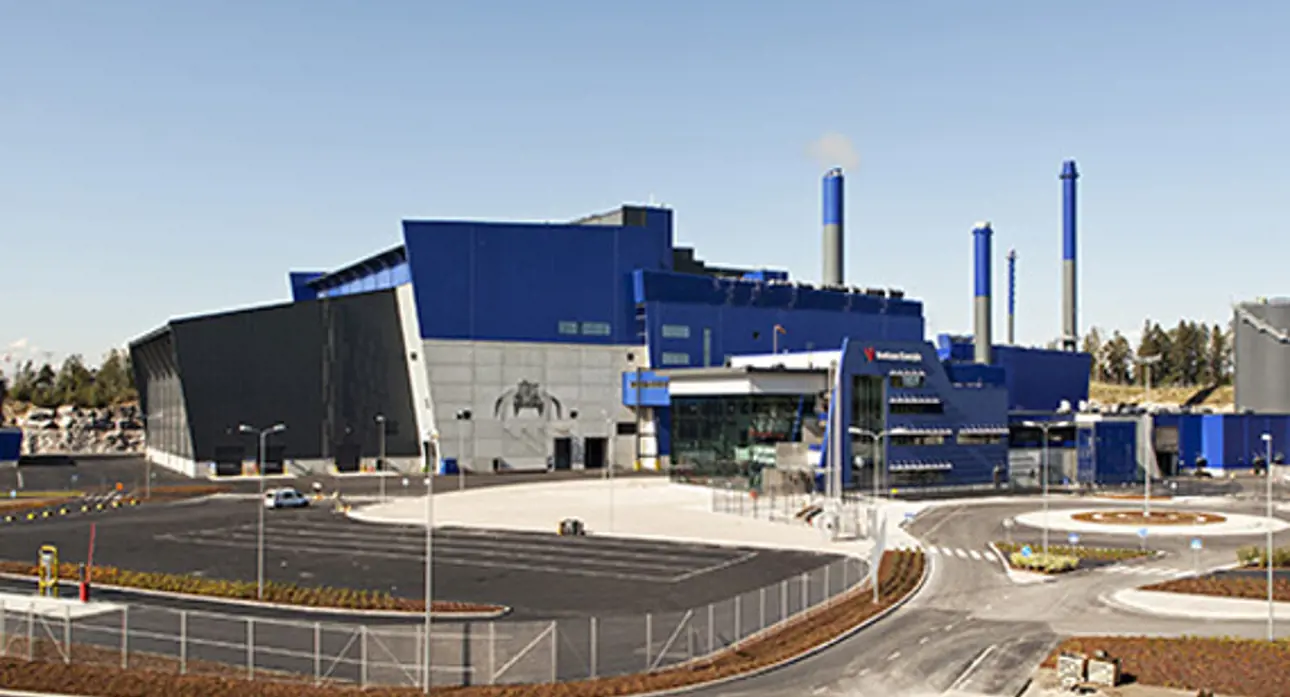Valmet’s technology moves Vantaan Energia’s district heat production capacity and energy efficiency forward
Aug 11, 2015

Vantaa Energy’s new waste-to-energy plant, located in Vantaa, Finland, at the crossroads of two major highways, features exceptional eye-catching architecture. One of the targets with it has been to improve the image of waste combustion in people’s minds. (Photo by Vantaan Energia, photographer: Olli-Pekka Orpo)
Officially inaugurated in September 2014, Vantaan Energia’s 300-million-euro waste-to-energy plant produces 920 gigawatt-hours (GWh) of district heat and 600 GWh of electricity per year. Its production meets about half of the city of Vantaa’s annual district heat need and about third of its annual electricity need. Many superlatives can rightly be used to describe Vantaa Energy’s greenfield waste-to-energy plant. In addition to representing the highest efficiency in its class, it is the largest in Finland and represents the most stunning industrial architecture.
The new plant has two combustion lines with two independent grate-fired steam boilers. To boost district heat production capacity and meet the ever-increasing energy efficiency needs, Vantaa Energy invested in Valmet’s advanced flue gas condensing technology to recover heat from the flue gases that otherwise would be wasted. Valmet’s delivery also included two tube condensers, one installed after each waste boiler, as well as condensate treatment equipment that is shared by the tube condensers.
14 MW more of district heat through flue gas condensing
Flue gas condensing is today often found at 
“Our main target was to improve energy efficiency, and Valmet’s flue gas condensing solution suited our needs very well,” says Kalle Patomeri, Project Director, Vantaa Energy. “I personally had previous good experience with Valmet’s flue gas scrubbing equipment from the early 2000s and thus have strong confidence in the company’s high-level technology and know-how.”
By condensing water vapor in flue gas with Valmet’s technology, the plant is able to produce 14 MW more of district heat. Annually, about 10% of its district heat production originates from flue gas heat recovery – free without any fuel.
According to Patomeri, the solution has functioned as expected and will in fact be developed further. “We are currently carrying out a development project that will use the condensate from the condensate treatment process as extra water in the boiler and the district heat network.”
A unique concept: HRSG produces steam and superheats
As a user of mixed waste as fuel, the plant has an excellent electricity production capacity of 80.5 MW. The secret lies in the very rare concept of integrating a gas turbine plant with a waste-to-energy plant. Patomeri continues. “In addition to us, there is only one other plant in the world that has the same design, but it is a condensing power plant. This combination provides us with 15 MW more electricity production.”
A key role in the concept is played by a heat recovery steam generator (HRSG) supplied by Valmet. In order to increase the overall efficiency of the power plant, live steam produced in the grate boilers is superheated in the HRSG together with additional steam generated by the waste heat from the gas turbine exhaust gases.
The waste incinerators produce high pressure steam of 88 bar and 400ºC. This steam is superheated in the HRSG to 535ºC before it enters the steam turbine. The HRSG also has a medium pressure steam circuit at 40 bar and 400ºC, which goes to the steam turbine and a low pressure steam circuit at 5.5 bar to produce auxiliary steam for the plant. The heat recovery boiler includes a district heating economizer and a condensate reheater. The capacity of the boiler is about 56 MWth.
“Valmet’s solution was economically competitive and features advanced technology. We were also familiar with the high capabilities of the engineering team from earlier projects carried out, for example, at our Martinlaakso power plant,” Patomeri says. “So far, the experience with the HRSG has been good, although we have not yet run it much. The gas turbine is on from fall to spring, and we just started it up in the third week of October.”
Long and good cooperation with Valmet
Cooperation between Vantaa Energy and Valmet started back in the 1980s and has since continued in numerous successful boiler projects. This latest one was another addition to the long track record.
“It was easy to carry out this project with a reliable partner. We are very satisfied with Valmet’s efforts and would make the same decision about the supplier if we had to do it again,” Patomeri concludes.